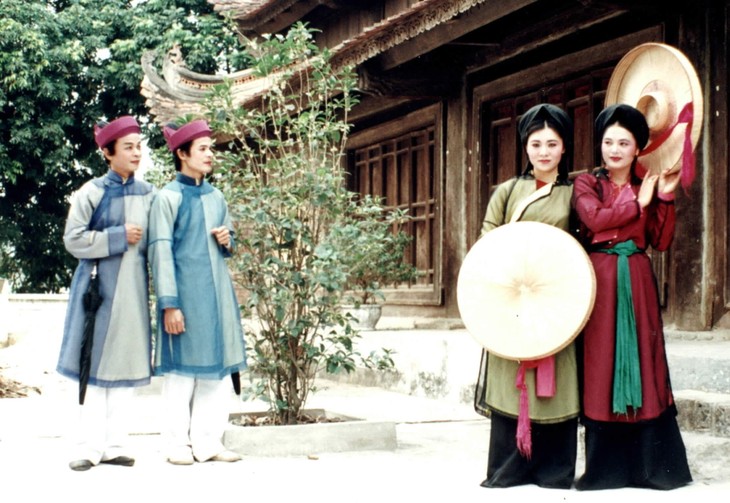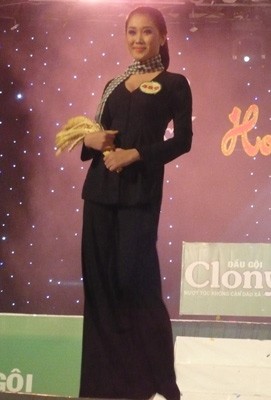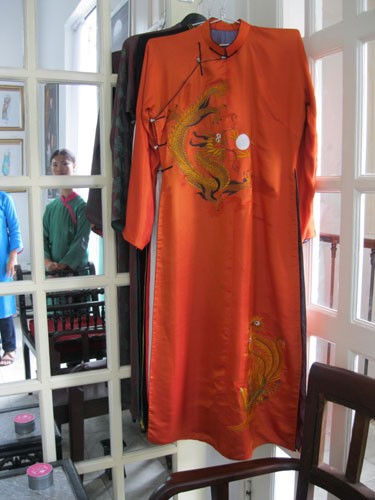(VOVworld) – The Viet clothes are diverse and differ by regions. On today’s edition of Colorful Vietnam-Vietnam’s 54 ethnic groups, VOV reporter Bui Hang explores the uniqueness of the Viet women’s clothes.
One of the most popular and casual clothes that northern rural women wore until the early 20th century was Ao tu than, the four-panel traditional dress. The top is a four part flowing tunic. The 2 front panels are tied together by a cloth belt without buttons, showing the Vietnamese brasserie or Yem, which is a piece of cloth covering a woman’s chest. An angle was cut to the neck and had two strings attached to fix it to the body. Yem, usually made of white silk, helps show a women’s attractiveness by highlighting the tapered shoulders and bee-shaped waist. Pham Bich Hang of the Vietnam Women’s Museum says:“The four-panel traditional dress with the front part attached together by a colorful silk belt creates charm and gracefulness. The dress always goes with a Vietnamese brasserie, a kerchief tired in a triangle on the forehead and flat palm hat with fringes. Such attire has always been worn by artists who perform Quan Ho folk singing”.
 |
| Quan Ho artists in ao tu than (Photo: sachtructuyen.info) |
Ao ba ba, the loose-fitting blouse is associated with southern women. Female farmers in the Mekong river delta used to wear a black blouse for their work in the field. The blouse is split on both sides along the hip and the two flaps form big outer pockets, making it convenient for wearers. Hang told VOV: “The designs of these loose-fitting blouses fit the southern environment. Local farmers usually wear black or brown blouses which are very convenient. Ao ba ba is worn with the Khan ran, a striped scarf, typifying Vietnamese women in the southern delta region”.
 |
| A contestant wears ao ba ba at a beauty contest (Photo: dantri.com.vn) |
Today, Ao ba ba has been modified into a close-fitting blouse with a collar. In the 1970s, the sleeves and shoulders of the blouse were seamless while the flaps were separated from the sleeves and shoulders. The sleeves were longer and flared. Sometimes, the outer pockets were removed, making the top look gentler.
The most famous traditional attire of the Vietnamese women is the ao dai, a long dress. It is designed to be close-fitting with a high collar. The front and back flaps flow from collar to knees in a long covering with loose trousers.
 |
| Ao dai designed by Trinh Hoang Dieu (Photo: VOV) |
Le Thi Luyen, owner of the Vinh Trach shop at 23 Luong Van Can street, Hanoi, has 60-year experience in tailoring ao dai: “Formerly, the sleeves and shoulders adjoined each other. The collar was about 3cm, not as high as it is now. Now ao dai is made in the raglan style, which is simpler. Ao dai beautifies femininity”.
Ao dai is made of different materials and decorated with embroideries or other hand made patterns. Pham Bich Hang says: “Ao dai symbolizes the cultural essence of the Vietnamese nation. Painter Cat Tuong has been a pioneer in modifying the dress. Despite many modifications, ao dai retains its traditional features and elevates the gentle beauties of the Viet women”.